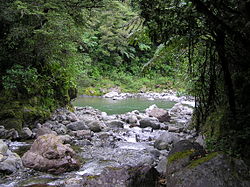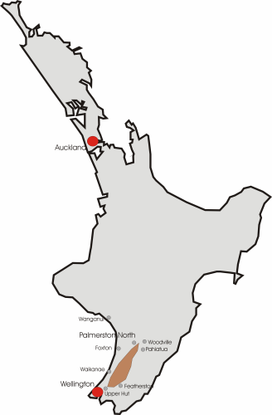Tararua Range
| Tararua Range | |
|---|---|
Pukeamoamo / Mitre | |
| Elevation | 1,570 m (5,150 ft) |
| Geography | |
North Island New Zealand and position of Tararua Range
| |
| Country | New Zealand |
| Region | Wellington |
| Range coordinates | 40°48′S 175°24′E / 40.8°S 175.4°E |
| Borders on | Remutaka Range and Ruahine Range |


The Tararua Range, often referred to as the Tararua Ranges or Tararua, is one of several mountain ranges in the North Island of New Zealand.
The Tararua Range runs northeast–southwest for 80 km (50 mi) from near Palmerston North to the upper reaches of the Hutt Valley, where the northern tip of the Remutaka Range begins. It is separated in the north from the southern end of the Ruahine Range by the Manawatū Gorge.[1] Most of the Range is wilderness, protected as the Tararua Forest Park.
The highest peak in the Tararua Range is
Geography
The Tararua Range is divided into two distinct northern and southern regions. Each of these is dominated by a central mountain peak: Arete in the north and Hector in the south. A total of ten rivers rise on the mountain slopes, providing water for the surrounding rural and urban areas from
Mountain peaks
The 15 peaks in the Tararua Range of 1,500 m or higher are (from north to south):
| Name | Elevation |
|---|---|
| Logan | 1,500 m |
| Bannister | 1,537 m |
| South Bannister | 1,513 m |
| Arete | 1,505 m |
| Lancaster | 1,504 m |
| Brocket | 1,538 m |
| Pukeamoamo / Mitre | 1,571 m |
| Peggys Peak | 1,545 m |
| Girdlestone | 1,546 m |
| North King | 1,535 m |
| Middle King | 1,521 m |
| South King | 1,531 m |
| McGregor | 1,540 m |
| Angle Knob | 1,510 m |
| Mount Hector | 1,529 m |
Other notable peaks in the range are Jumbo Peak (1,405 m) and Mount Holdsworth (1,470 m).
Climate and vegetation
The western slopes of the ranges are subject to prevailing moisture-carrying winds, channelled by Cook Strait to the south. These are the source of an annual rainfall of approximately 5,000 mm, resulting in the dominance of conifers, ferns and shrubs on the western side of the ranges. By contrast, the pattern on the eastern side is one of open beech forest in a drier environment.[1] In spite of a reputation of being composed of gloomy bush, impenetrable
The forest in the northern part of the Tararua Range consists mainly of
History
The rugged terrain and frequently harsh weather of the Tararua Range served to discourage any substantial attempt at penetration by early Māori. Although there is archaeological evidence of exploration by
In the 1870s a large portion of the ranges was sold to the New Zealand Government by a coalition of the Iwi in possession of the surrounding region. Specifically excluded from this "Tararua Block" purchase was an area of 1,000 acres reserved to protect the
Tararua Forest Park

The 116,535 hectare
Roads
The only all-weather road right across the range is the Pahiatua Track, which joins Palmerston North and Pahiatua. It is now used more heavily since the Manawatū Gorge road was permanently closed in 2017 due to recurring large landslides.[citation needed]
Recreation
The Tararua Range serves as a popular
Camping

The hills include 6 campsites.[11] They are accessible by car, although visitors may need to travel over gravel roads that contain occasional fords. Campsites are generally located within the foothills of the range, alongside a river or stream.
Tramping

The Tararua Range is significant in the history of tramping in New Zealand, due to its accessibility for people in Wellington and nearby towns. Two of the most popular tracks are the
.The Sutch Search
In April 1933, the Tararua Range was the focus of what later came to be known as
Tramping fatalities
A combination of steep terrain, dense bush, difficult river crossings and changeable winter weather conditions has caused over twenty-two tramping deaths in the Tararua Range since 1970, most recently one in January 2023.[15]
Other deaths included those of the Chief Executive of the
Mountain running racing
The Tararua Mountain Race, following a track of 35.4 km (22.0 mi), from Kaitoke to Ōtaki Forks, has been held annually since 1990. The running race involves a total ascent of 2,250 m (7,380 ft) plus a slightly longer descent, and requires the deployment of 50 volunteers as marshals, search and rescue teams, first aid helpers, and support staff.[17] It frequently encounters adverse weather and is not regarded as a suitable event for inexperienced participants.
See also
References
- ^ a b c d Maclean, Chris (3 March 2011). "Wellington places – Tararua Range". Te Ara – the Encyclopedia of New Zealand. Retrieved 16 July 2012.
- ^ Maclean (1994), pp. 26–30
- ISBN 0-86863-466-2.
- ^ "Vegetation in Tararua Forest Park". Department of Conservation. 2012. Retrieved 31 December 2012.
If you think the vegetation of the Tararua Range is just gloomy bush, impenetrable leatherwood, and wet snow tussocks on the mist-shrouded tops you will be pleasantly surprised if you look closer.
- ISBN 0-86863-466-2.
- ^ Maclean (1994), page 41
- ^ Maclean (1994), pages 68 and 78
- ^ Maclean (1994), pp. 68–71
- ^ Maclean (1994), pp. 106–107
- ^ Dominion Post. Retrieved 8 October 2019.
- ^ Department of Conservation. "Tararua Forest Park". Retrieved 7 January 2019.
- ^ Maclean (1994)
- ^ "History of LandSAR in New Zealand". New Zealand Land Search and Rescue. Retrieved 13 January 2012.
- ^ Mike McGavin (27 August 2010). "Re-living the Sutch Search". Windy Hilltops. Retrieved 13 January 2012.
- ^ Schwanecke, Gianina (13 January 2023). "Family farewell tramper who died in Tararua Range". Stuff. Retrieved 5 March 2023.
- ^ Dominion Post, 15 July 2009
- ^ http://www.tararua-race.org.nz Archived 2013-05-04 at the Wayback Machine
Sources
Maclean, Chris (December 1994). Tararua: The Story of a Mountain Range. Whitcombe Press.
External links
- Tararua history Department of Conservation
- Tararua Northern Crossing Department of Conservation
- Tararua Southern Crossing Department of Conservation

